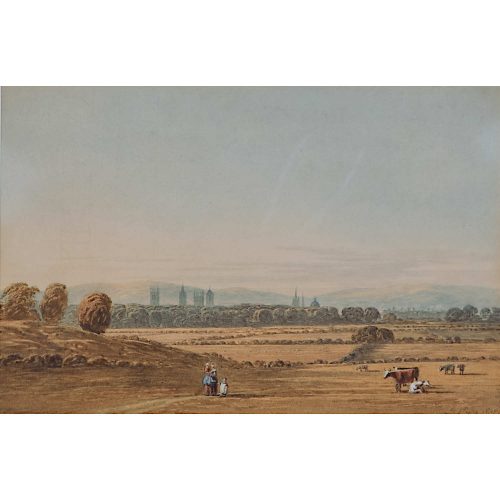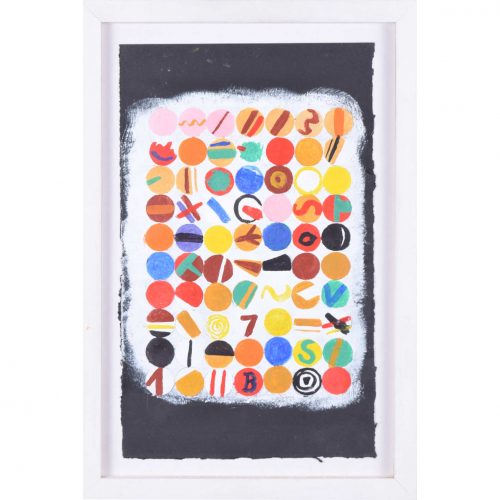-
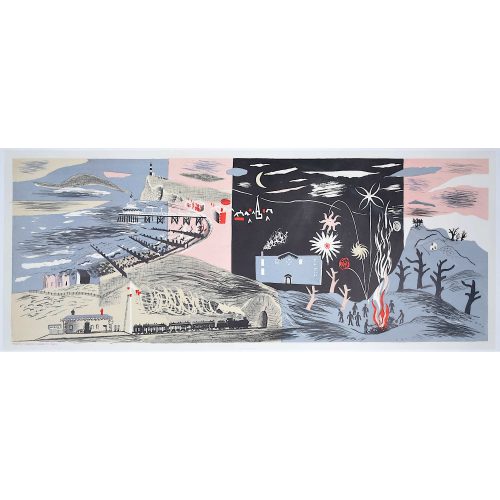
John Piper C.H. (British 1903-1992) Nursery Frieze II
500 x 1250 mm Lithograph 1936 One of Piper's many seascapes, Frieze II is an exercise in abstract capriccio. Piper draws together the muted grey, pink, and blue of the lithograph's fragmented background with foreground details in black, white, and bright red, picking out particular moments of the frieze for the viewer. The lighthouse has no keeper; the beach and the pier are empty; the train has neither passengers nor driver. The church at the top of the rocky hill is a brilliant cubist borrowing, showing both the West end and the North side simultaneously - and it has no congregation. The only human figures present in the frieze are those collected around the bonfire, watching the flames and the show of fireworks. The scene is at once devoid of people and intensely human. Piper was just 24 when he made Frieze II. If you are interested, please email info@manningfineart.co.uk or call us on 07929 749056. Condition: Generally very good, backed to linen with small - and largely not visible - areas of restoration. -
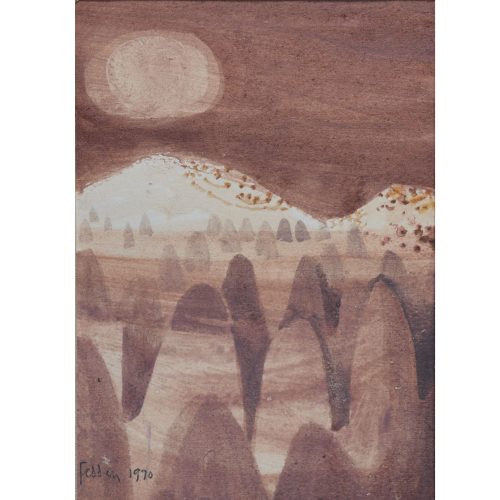
Mary Fedden (1915-2012) Moonlight at Cappadocia (1970)
Watercolour 18 x 13 cm Signed and dated lower left Lonely Planet says of Cappadocia, "As if plucked from a whimsical fairytale and set down upon the stark Anatolian plains, Cappadocia is a geological oddity of honeycombed hills and towering boulders of otherworldly beauty." Here Fedden presents an almost surreal landscape, where the forms of rocks, sky, and moonlight swim out of a subtle palette. If you are interested, please email info@manningfineart.co.uk or call us on 07929 749056. Condition: Excellent. In original frame with replacement mount in the style of the original. -

Brendan Neiland (b.1941)
Original Designs for Intercity Posters - Edinburgh and York
Collage, spraypaint and cut out 91x58cm (36×23 inches) each 1991 Click here for biographical details and other works by the artist. If you are interested email info@manningfineart.co.uk or call us on 07929 749056. -
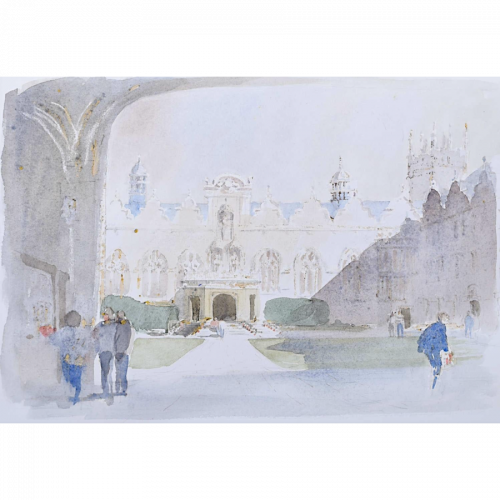
Hugh Casson (1910 - 1999)
Oriel College, Oxford
27 x 39 cm Watercolour We are lucky to be able to offer here the original watercolour from which Casson’s print of the College was produced. We also (elsewhere on the site) offer the print from his ever-popular Oxford and Cambridge series. Sir Hugh Casson was educated at Eastbourne College; St John’s College, Cambridge; and the Bartlett School of Architecture. Trained in the 1930s in the early modernist style, he taught at the Cambridge School of Architecture. After employment as a camoufleur during World War 2 by the Air Ministry, in 1948 he was appointed as director of architecture for the Festival of Britain. A close friend of the Royal Family, he undertook designs for the 1953 coronation, designed the interior of the Royal Yacht Britannia (“The overall idea was to give the impression of a country house at sea”), and taught the Prince of Wales to paint in watercolours. Amongst his architectural achievements are the Elephant House at London Zoo, the 1978 redevelopment of Bristol Docks, the Raised Faculty Building for The University of Cambridge, and a building for the Royal College of Art. He published a number of illustrated books, of which Casson’s Oxford and Casson’s Cambridge are probably the best known. A limited edition series of prints was produced from the paintings. Condition: excellent. If you’d like to know more, please email info@manningfineart.co.uk or call us on 07929 749056. -
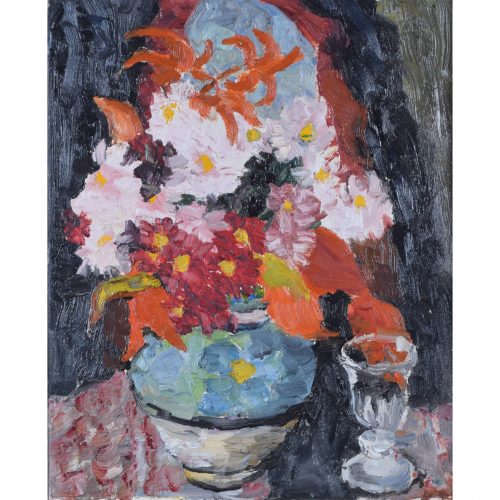
Eva Lucy Harwood (1893 - 1972)
Still Life with Flowers and Glass
Oil on canvas 49 x 40 cm ( 67 x 57 cm framed) A mid-century still life typical of Harwood's impasto style. Lucy Harwood was a British artist who studied art at the Slade just before the outbreak of the First World War. She had initially intended to be a professional pianist, but turned her attentions to visual art after becoming partially paralysed. She was one of the first students to enrol at Cedric Morris' East Anglian School of Drawing and Painting, where she focused on painting Post-Impressionist landscapes, painting just with her left hand. She moved to Upper Layham in Suffolk and is known for her landscapes of the area. Condition: generally very good. Handsome hand-finished frame. Provenance: Louise Kosman, Edinburgh. If you’d like to know more, please email info@manningfineart.co.uk or call us on 07929 749056. Click here to view our other still life pictures. -
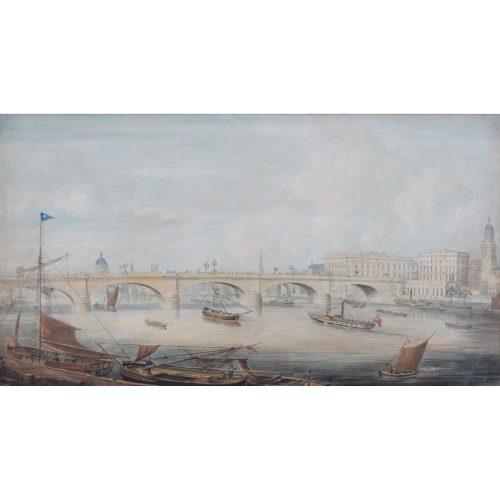
Gideon Yates (?1790-?1840)
1831 View on The Thames with London Bridge from the East Side showing Fishmonger's Hall, The Church of St Magnus the Martyr and St. Paul's Cathedral.
c.1831 29x54cm Watercolour unsigned Provenance: The Parker Gallery LIttle is known of the life of Yates. Even his date of death is disputed with some sources putting it at 1837. What is known is that he spent most of his working life in London, producing many detailed views of The Thames such as this one. His style is very distinctive, and this large and impressive view of London Bridge is a typical view. He is thought to have lived in Lancaster in 1811, and to have travelled widely throughout Britain and the Continent. His works are in public collections including the Victoria and Albert Museum. In this view, Thames barges are in the foreground with their distinctive brown sails. A steamship proceeds along the middle of The Thames. The first steamboat patented was in 1729, by John Allen an English physician. However it was not until 1783 that the first steam-powered ship, "Pyroscaphe," was demonstrated on the River Saône. By 1788 John Fitch in Philadelphia was operating a commercial service along the Delaware River were built in the United States. The first sea-going steamboat was the "Experiment" built by Richard Wright in 1813; by this point river services were becoming well established although it was not until 1815 that The Thames acquired its first successful services with "Margery" and "Thames" arriving from the Clyde where they had been in service for some years. Margate and Gravesend were the main destinations. The steamboat in this view is a paddlesteamer, with two side wheels. At the north end of London Bridge (on the far side from the viewer) is Fishmongers' Hall, St Magnus the Martyr Church is visible on the near side of the bridge, and St Paul's Cathedral is visible beyond. UK Government Art Collection item 6701 is another view of The Thames by Yates, also from The Parker Gallery. If you are interested email info@manningfineart.co.uk or call us on 07929 749056. -
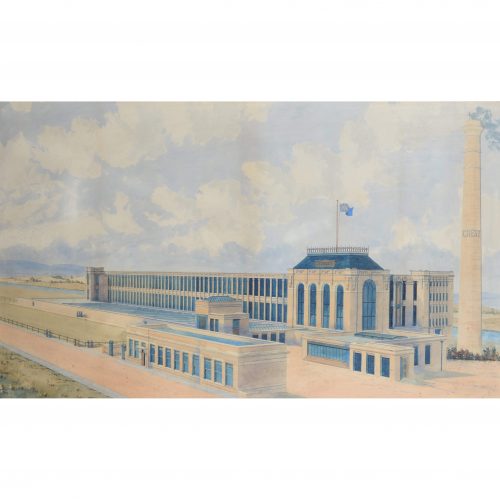
Crest Mill, Castleton, Rochdale, Lancashire (1906)
Watercolour 56 x 96 cm Crest Mill in Castleton, Rochdale, was built in 1906. It was designed by Sir Philip Sidney Stott, the English architect, civil engineer and surveyor. Crest Mill was demolished long ago. The mill engines were sent to the United States, but the ship carrying them sank in the Atlantic. Scott's mill chimneys all had two distinctive bands towards the top. Stott was born in Chadderton, Lancashire, and joined the family firm of architects upon leaving school. In 1883, he set up his own business, P. S. Stott, specialising in the design of cotton mills - he designed 22 mills in Oldham and 55 elsewhere in the county, plus many more in Europe, India and the Far East, amounting to 124 in total. He became a baronet in 1920, and was elected a Fellow of the Society of Architects and a member of the Royal Institute of British Architects. He was a significant figure in Lancashire mills, being responsible for 40% of the spindles laid down in Oldham between 1887 and 1914, and 44% of the increase in Lancashire's spinning capacity between 1887 and 1925. He retired a wealthy man having accumulated shares in the mills he designed. Condition: generally very good; some slight staining marks to mount, and possible faint time staining in areas. If you are interested, please email info@manningfineart.co.uk or call us on 07929 749056. Click here for more architectural perspectives. -
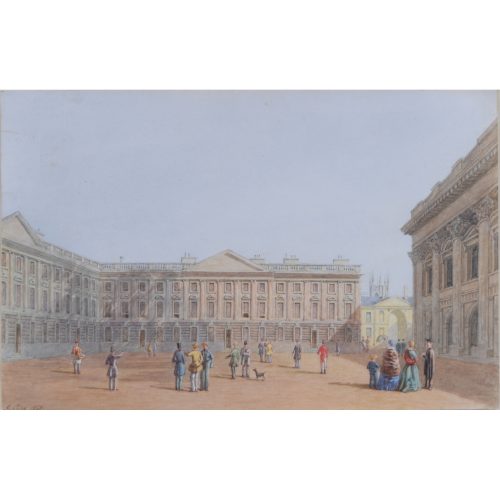
George Pyne (1800 - 1884)
Peckwater Quad, Christ Church, Oxford
Watercolour 27.5 x 17.5 cm Signed and dated 1849. A marvellous view of the Peckwater Quadrangle, more affectionately referred to as Peck Quad and known for having arguably the best undergraduate rooms in all of Oxford. The buildings on the north, east and west sides of the quad were designed by Henry Aldrich are one of the earliest examples of English neo-Palladian architecture. They were built by William Townsend between 1706 and 1711, while the Library on the south side was completed later in the eighteenth century. Peck looks rather different today - it is now mostly filled with lawn and hosts Christ Church's extremely large Christmas tree each year. In Pyne's day it was lawnless and filled with elegant pedestrians in nineteenth-century costume; in this view, afternoon light slants down over the buildings, and the lengthening shadows cast by the library creep into the quad. George Pyne was related to two founders of the Society of Painters in Watercolours - William Henry Pyne was his father, and John Varley his father-in-law. Pyne trained as an architectural draughtsman and lived in Oxford from the 1850s until his death in 1884, specialising in views of the city and its colleges. His Oxford pictures are both architecturally-minded and romantically creative, often combining intensely detailed depictions of college buildings with imagined pedestrian scenes. Pyne was also noted for his views of Cambridge and Eton, and for his drawing manuals 'A Rudimentary and Practical Treatise on Perspective for Beginners' (1848) and 'Practical Rules on Drawing for the Operative Builder, and Young Student in Architecture' (1854); the latter texts offer an insight into his method of depicting architecture and its surroundings. Condition: very good. If you are interested, please email info@manningfineart.co.uk or call us on 07929 749056. Click here for other views of Christ Church. -

George Pyne (1800-1884)
Great Court, Trinity College, Cambridge
Signed G Pyne 1850 Watercolour 20.5 x 29 cm (8 x 11.5 in.) It appears Pyne spent some time painting in Cambridge in 1849-50. This is - for Pyne - an unusually large composition; a fine watercolour of Trinity Great Court, with King’s College chapel in the background and elegant figures in the court. It is a particularly pleasing composition. Click here for biographical details and other works by the artist. If you are interested email info@manningfineart.co.uk or call us on 07929 749056. -
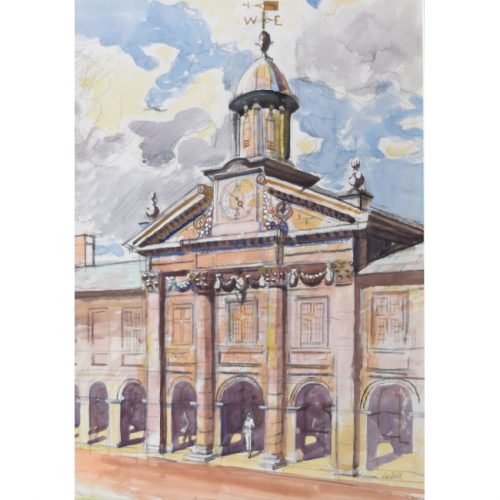 Edwin La Dell ARA (1914-1970) Emmanuel College Cambridge Signed Watercolour
Edwin La Dell ARA (1914-1970) Emmanuel College Cambridge Signed Watercolour46x32cm (18.11 X 12.6 in)
In fine original hand-finished painted frame.
Click here for biographical details and other works by the artist. If you are interested email info@manningfineart.co.ukor call us on 07929 749056. -

John Piper (1903 - 1992)
Radcliffe Camera
Lithograph 53 x 35.5 cm Numbered 110/1150 lower left and signed lower right in pencil. John Piper's view of the Radcliffe Camera in Radcliffe Square. John Piper CH was an English painter, printmaker, and designer of stained-glass windows. His work often focused on the British landscape, especially churches and monuments, and included tapestry designs, book jackets, screen-prints, photography, fabrics and ceramics. Condition: very good. Attractively framed; frame included for mainland UK shipping only. If you are interested, please email info@manningfineart.co.uk or call us on 07929 749056. Click here for other views of Oxford. -
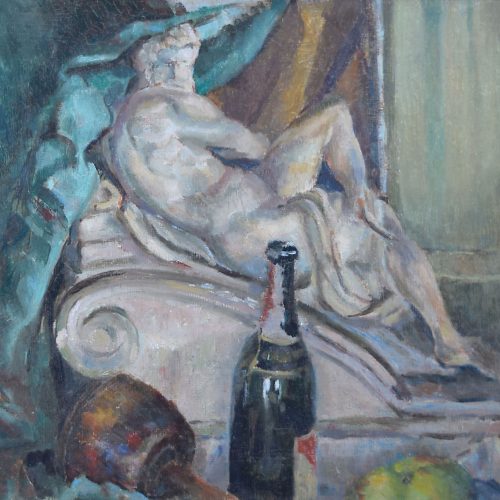 Sir Terry Frost (1915-2003) Bottle and Statue Oil on board c. 1947 38 x 46cm A distinctive still life featuring bottle, statue, and drapery. Terry Frost was a prominent British abstract artist. Frost is most noted for his simplistic abstract forms and unusual colour; he worked alongside the St Ives group and as Barbara Hepworth's assistant for several years, his artistic style being heavily influenced by them. In 1992 he became a Royal Academician, and he was made Sir Terry Frost in 1998. Bottle and Statue highlights Frost's unique compositional skill. His brushwork makes the statue seem like a real nude, who, framed by turquoise and ochre draperies, examines the still life in the foreground. An early work, painted shortly after the War and prior to his adoption of abstraction. For other works by Frost and biographical details please click here. Condition: A little craquelure in the oil above the statue's head.
Sir Terry Frost (1915-2003) Bottle and Statue Oil on board c. 1947 38 x 46cm A distinctive still life featuring bottle, statue, and drapery. Terry Frost was a prominent British abstract artist. Frost is most noted for his simplistic abstract forms and unusual colour; he worked alongside the St Ives group and as Barbara Hepworth's assistant for several years, his artistic style being heavily influenced by them. In 1992 he became a Royal Academician, and he was made Sir Terry Frost in 1998. Bottle and Statue highlights Frost's unique compositional skill. His brushwork makes the statue seem like a real nude, who, framed by turquoise and ochre draperies, examines the still life in the foreground. An early work, painted shortly after the War and prior to his adoption of abstraction. For other works by Frost and biographical details please click here. Condition: A little craquelure in the oil above the statue's head. -
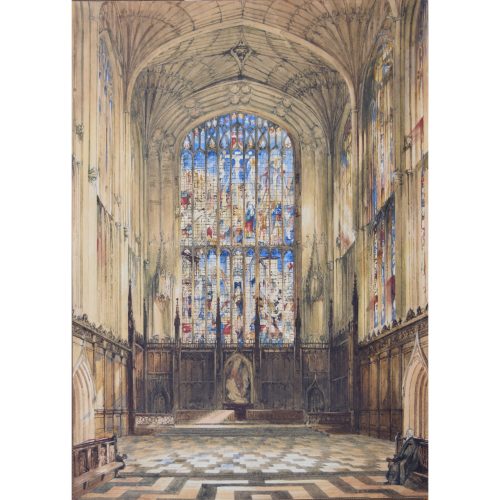
John Anderson Bell (1809-1865)
King's College Cambridge Chapel Interior
Signed and indistinctly dated Watercolour c. 1840 53x39cm Bell was born in Glasgow; his father was James Bell, advocate and his sister Jane Cross Simpson the hymn-writer and poet. Following Edinburgh University Bell spent 1829 and 1830 in Rome as an art student, returning to the UK to serve his articles as an architect with Rickman & Hutchinson, the gothic revivalist practice in Birmingham. Subsequently he practised in Edinburgh, designing country houses, and the Victoria Buildings in Glasgow for the Conservative politician Archibald Orr Ewing in Scottish baronial style. Thirty of the engravings in John Le Keux's magnificent 1847 book Memorials of Cambridge are from paintings by Bell; this particular painting is believed to have been painted at the same time, although not published. The Great East Window depicted in the painting was created between 1526 and 1531 by Gaylon Hone and three partners (one Flemish and two English) and - together with the other sixteen they made - represent some of the finest stained glass of their period. Here Bell has captured the colours and the light of the window in almost magical fashion. It is an interesting view as it records the chapel in the mid nineteenth century. In 1968 the installation of Rubens' the Adoration of the Magi as an altarpiece involved the lowering of the Sanctuary floor through removal of the steps clearly visible in Bell's view and also removal of the seventeenth century panelling around the walls. It is still felt that the chapel would have been better left 'unimproved' and without the Reubens, though the form recorded by Bell had itself been improved in 1906 when Detmar Blow designed a reredos. Blow's reredos remains in storage in the College. The East window may be viewed in high resolution in the series of seven short films - accompanied by music by King's alumnus Francis Grier - entitled Sword in the Soul. -
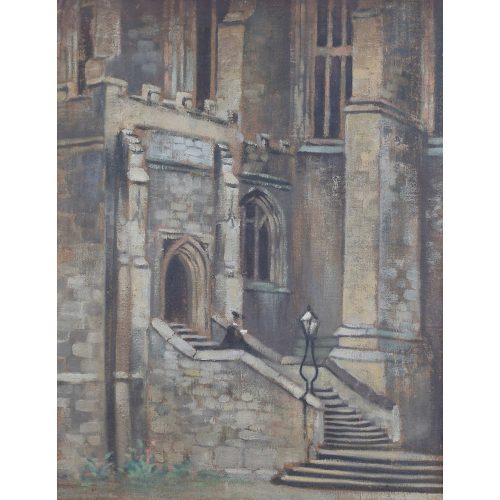
'Eton College, a scholar on the steps' (early 20th century)
Oil on canvas 62 x 49 One of our favourite paintings. A lone scholar descends the Chapel steps, a human focal point in an oil painting primarily concerned with the College's fine architecture. A blur of green and red sprouts at the bottom of the wall - flowers. In a handsome period hardwood frame. Condition: very good.

